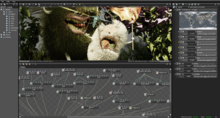| Revision as of 08:49, 25 December 2019 editAlexjferraro (talk | contribs)2 edits added Octane Render Overview; Added Octane Render Features← Previous edit |
Revision as of 12:25, 25 December 2019 edit undoMoneytrees (talk | contribs)Autopatrolled, Checkusers, Administrators29,838 edits Undid revision 932359250 by Alexjferraro (talk)copyvio from: https://home.otoy.com/render/octane-render/featuresTag: UndoNext edit → |
| Line 26: |
Line 26: |
|
Octane Render runs exclusively on ]'s ] technology, restricting it to Nvidia ]; Octane Render 2019 is planned to run on ] and therefore will be able to run on both AMD and Nvidia graphics cards. |
|
Octane Render runs exclusively on ]'s ] technology, restricting it to Nvidia ]; Octane Render 2019 is planned to run on ] and therefore will be able to run on both AMD and Nvidia graphics cards. |
|
|
|
|
|
OctaneRender is the world’s first and fastest unbiased, spectrally correct GPU render engine, delivering quality and speed.<ref>, 2019-12-25</ref>; |
|
|
|
|
|
OTOY is advancing state of the art graphics technologies with groundbreaking machine learning optimizations, out-of-core geometry support, massive 10-100x speed gains in the scene graph, and RTX raytracing GPU hardware acceleration.<ref>, 2019-12-25</ref>; |
|
|
|
|
|
|
|
|
==Features== |
|
|
'''Volumetric Rendering''' |
|
|
Octane Render supports rendering of particulate matter such as clouds, smoke, fog and fire with varying densities and introduces a unique native primitive type for incredibly detailed micro-surface displacement volumes and surfaces required to render photo-realistic natural and organic materials. |
|
|
|
|
|
'''Deep Pixel Rendering''' |
|
|
Octane Render adds deep pixel rendering support as well as live connecting of DCC and compositing apps through the Octane Render for Nuke plugin. |
|
|
|
|
|
'''OSL''' |
|
|
Octane Render supports Open Shading Language, enabling artists to create their own shaders and bring custom shaders from other software directly into Octane Render projects. |
|
|
|
|
|
'''Live Texture Baking''' |
|
|
Octane Render supports unbiased GPU texture baking (UV or volumetric) of global illumination, spherical harmonics and 8D light fields. |
|
|
|
|
|
'''Speed''' |
|
|
Leveraging the power of the GPU, Octane Render can render final quality images 10x to 50x faster than CPU-based, unbiased rendering engines. That means, no more "get up and wait" in your workflow. |
|
|
|
|
|
'''Interactivity''' |
|
|
Octane Render's on-screen viewport is the final render. Any changes to the scene are instantly updated on the screen allowing you to tweak any setting and view the results immediately. |
|
|
|
|
|
'''Live Texture Baking''' |
|
|
Octane Render supports unbiased GPU texture baking (UV or volumetric) of global illumination, spherical harmonics and 8D light fields. |
|
|
|
|
|
'''Flexibility''' |
|
|
Octane Render isn't tied to any single modelling package, and it supports more than 21 plugins. No matter what your workflow is, we probably have a plugin for it. Want to switch between different modelling tools? We also support that with our common interchange format, .ORBX. |
|
|
|
|
|
'''Lighting''' |
|
|
Octane Render supports HDRI, mesh emitters, IES files, and a planetary sun/sky system. Rotate an HDRI file to position it in your scene, or turn any object into a mesh light by enabling the emission property of the material. With the additional Light Linking and Light Exclusion features, OctaneRender allows you to manipulate the lighting in a scene, however you choose. |
|
|
|
|
|
'''Materials''' |
|
|
Octane Render supports subsurface light scattering (SSS), complex IOR, chromatic dispersion, and absorption to create some of the best materials in the industry. Use the node editor to create complex materials from procedural textures, or quickly pull a material from our OctaneLive Material Database. In addition to OSL Textures, Octane Render supports metallic materials, toon shaders, and allows importing complex PBR textures through a universal uber material node. |
|
|
|
|
|
'''Toon Shading''' |
|
|
Turn your photo-realistic renders into dynamic, toon-shaded scenes with just one material application. |
|
|
|
|
|
'''Octane Denoiser''' |
|
|
Render noise-free images in a fraction of the time with Octane Render’s own denoising implementation with huge advantages over ]. |
|
|
|
|
|
'''Out of Core Geometry''' |
|
|
Octane Render can render fast out-of-core geometry from CPU memory, with minimal speed loss, even across multiple GPUs - a first for an unbiased GPU renderer. |
|
|
|
|
|
<ref>, 2019-12-25</ref>; |
|
|
==References== |
|
==References== |
|
{{Reflist}} |
|
{{Reflist}} |

